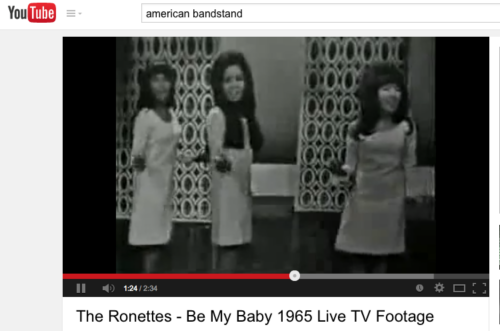
 During my post-college, single-in-the-city years, I almost never watched TV. Time spent alone in my Upper West Side digs meant time spent reading or listening to music—rock, classical, disco, jazz, whatever the mood called for. A solid state Fisher stereo was all I had room for and the sound was stupendous. Pump up the volume, Graham Parker or Donna Summer, and Saturday A.M. cleaning took on a whole new beat. My solo weeknight TV viewing largely consisted of old movies or a PBS special. Late-night Saturday TV with friends, or a boyfriend, was another thing altogether.
During my post-college, single-in-the-city years, I almost never watched TV. Time spent alone in my Upper West Side digs meant time spent reading or listening to music—rock, classical, disco, jazz, whatever the mood called for. A solid state Fisher stereo was all I had room for and the sound was stupendous. Pump up the volume, Graham Parker or Donna Summer, and Saturday A.M. cleaning took on a whole new beat. My solo weeknight TV viewing largely consisted of old movies or a PBS special. Late-night Saturday TV with friends, or a boyfriend, was another thing altogether.
It was the boyfriend who would become my husband who would eventually hook me on two of his favorite sitcoms, “Cheers” and “Seinfeld. “ I dismissed them at first—like, please, don’t waste my time. These days, late at night in bed, you can hear me laughing out loud at some of the brilliant “Seinfeld” dialogue. I’ve seen reruns of classic episodes more than once.
When the daughter came along, there was no escaping “Sesame Street.” And why would I want to? Only a fool could resist the charms of Elmo. Don’t have to be a Springsteen fan to see Born to Add for the delightful parody it is, though the humor of “Miami Mice” might be lost on you if you never saw Don Johnson and Philip Michael Thomas in action. Educators may differ in their views re: the nuances of teaching children the three R’s and where a ground-breaking show like “Sesame Street” figures into the picture, but there’s no arguing the brilliance of luring mom and dad into the clever riffs on pop culture.
In a wonderful interview with Krista Tippett, folklore/mythology scholar Maria Tatar reminds us that entertainment in days of old was of the sit-around-the-fire-and-tell-stories variety. There was interaction, and the nature of fairy tales, once they were collected and chronicled by the Brothers Grimm, began to change. R-rated fairy tales originally narrated by and for adults softened to PG as they morphed into children’s stories. Morals crept in, and with them, the happy ending. The violence in fairy tales was surreal, burlesque, carnivalesque.
Times change, literary arts evolve, but the very undercurrent of fairy tales just won’t go away. From “Buffy the Vampire Slayer” (which my daughter lured me into watching with her) to “True Blood” to “Grimm” and “Once Upon a Time” (which fascinates me for its interplay among fairy tale characters caught between worlds), content adapts itself to motif. It doesn’t take a rocket scientist to see Cinderella in Carrie Bradshaw. She even loses a shoe in one episode. And isn’t there a touch of the fairy godmother at play in handing a book contract, followed by a plum magazine job to the novice Hannah Horvath in “Girls”? That her own self-absorption is her constant undoing can’t be helped; it’s part of the character, an anti-Cinderella who wants her dreams fulfilled but lacks the generosity of spirit inherent in a humble fairy-tale heroine.
The irony? We may think we’re watching TV to escape the real world, only to find ourselves pulled into a world more unsettling in the reality it portrays. Yes, it’s stylized, fictionalized, often too formulaic. But like the best of stories, a show like “Girls” gets us talking. It’s the nature of how we live, sharing stories; it’s something children learn the minute we introduce them to bedtime books and they squeal: read it again . . . and again . . . and again. Or listening as carefully as they do, they stop us if we skip a line.
So when I’m propped in bed, watching “Once Upon a Time” on my iPad, the comfort of years and years of nighttime reading insinuates itself into the experience. That I can watch episode after episode in one sitting only proves that technology strives to give us what storytellers have always known.
And when I read a comment from my dearest childhood friend in response to my daughter’s reflection on “Girls,” in an instant I’m transported to another once-upon-a-time, teendom, BFFs sitting together, any day of the week after school, tuning in to “American Bandstand.” It’s what girls did. It’s what we still do. Even if we’re not in the same room looking at the same screen, we’re texting about it, posting on Facebook, generating conversation via blog posts.

